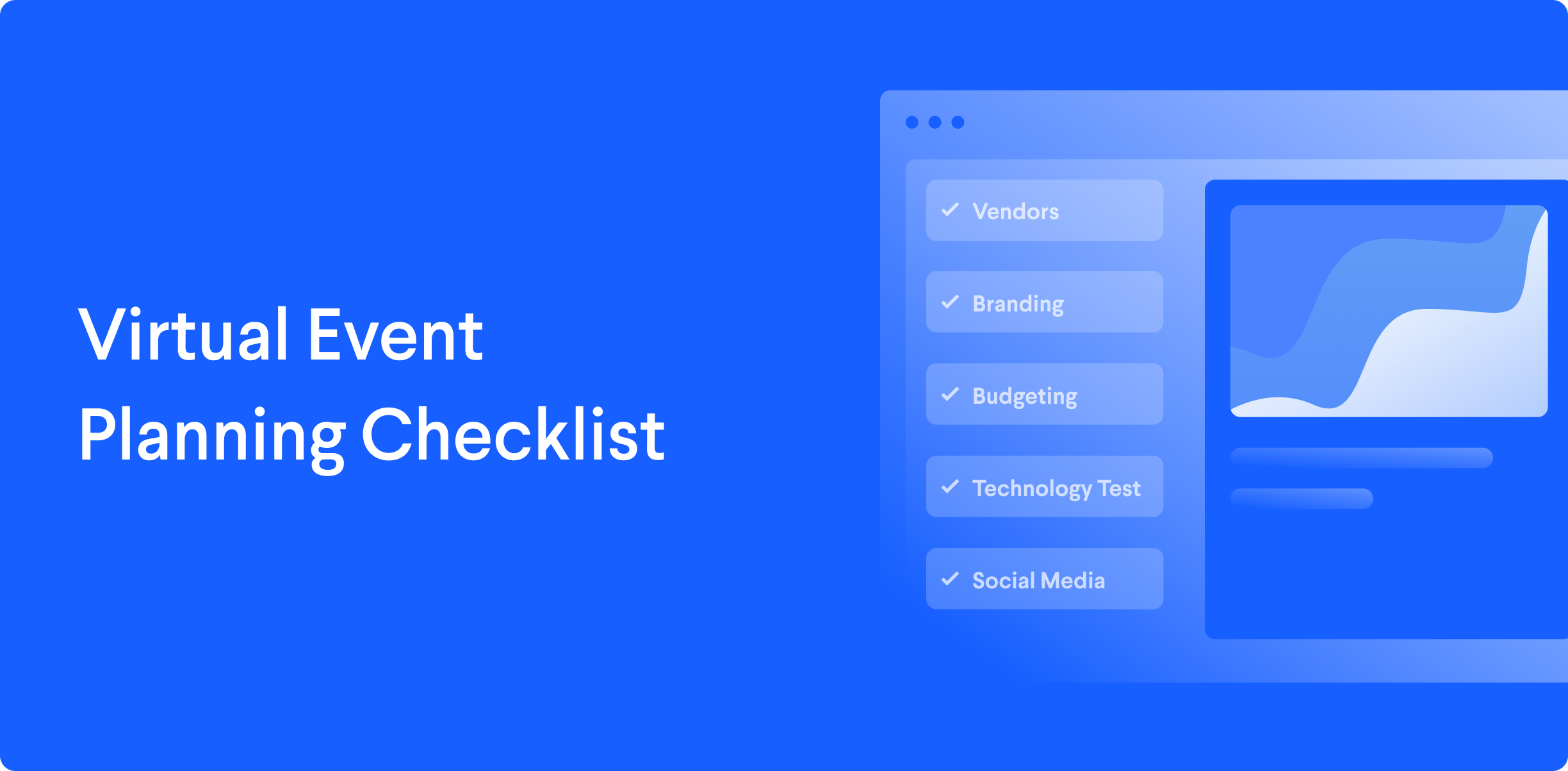
The virtual conference checklist has become one of the most essential elements of any event planner’s toolkit. Ask any meeting and event planner about their go-to event tool, and most will mention their list. A checklist makes the to-dos more manageable and provides sanity-saving peace of mind too.
There isn’t a “one size fits all” when it comes to a checklist for virtual conferences and you’ll probably want to put your own mark on it so we’ve asked our event planners to cover the basics.
We’ve put together an easy to follow essential virtual conference planning checklist to use when planning your next virtual event.
But first a quick word about the budget. It is true that there are likely to be some savings on a virtual event vs a live event, but in real terms, it might just be a re-focus of where that spend goes. For example, a live event budget would be spent on venues, F&B, staffing, travel, etc. Whereas, on a virtual event the focus is likely to be on technology and connecting people.
Correct ‘investment’ in your tech can mean the difference between an average online event and a successful conference where participants are engaged and your objectives are achieved.
Virtual Conference Checklist at a Glance
Now you’ve thought about budgets here’s our 9 point virtual conference checklist at a glance:
- Identify your virtual event goals
- Build an event content plan
- Implement a virtual event promotional plan
- Prepare the virtual experience
- Engage virtual event attendees
- Capture event data
- Send a feedback survey
- Do an event “de-brief”
- Send a post-event wrap up
Before the virtual event
1. Identify your event goals
Virtual events require a clear focus. Much the same as live events, you should understand what it is you are looking to achieve from your virtual event. You should identify what the purpose of the event is and the goals needed to make this a success. Do you want to outline annual sales targets, launch a new product to a marketplace or simply create a connection with an audience through networking? Having a clear event focus throughout your planning process is key.
When you have this event focus you can make goals to gauge success. Make these easy to measure. For example, using a single event technology platform, gives you easy access to all your event data. With less “tangibility” to a virtual event, you’ll need this to understand whether it has been a success.
2. Build an event content plan
Unless you are running a hybrid virtual event it is unlikely you’ll have venue finding considerations. That makes one of your first tasks creating the content plan. Content is crucial in driving attendance and engagement. With a virtual event, attendees have plenty of distractions to drag them away – so content is your priority. Keep it relevant, concise and think about the best ways to deliver each of these content elements.
3. Implement a virtual event promotional plan
Build and launch a promotional plan for your event. If applicable, create dedicated social media profiles for your event – this can help with measuring engagement goals. If you’re not using a dedicated event platform, you could think about creating a virtual event website or landing page to base the promotion. Email marketing is often a pivotal part of event promotion and you can schedule a series of pre event communications well in advance.
4. Prepare the virtual experience
The prominence of Zoom, Microsoft teams and Google hangouts mean that most are at least familiar with the workings of a virtual meeting. Sending attendees and speakers a “Know Before You Go” email can really help improve the virtual experience. A larger-scale conference or corporate kick-off is likely to be a little more complex than simply ‘joining a meeting’. Even if your virtual event platform is easy to use, your attendees may not be familiar with it.
Test the platforms. Be prepared to run “Livestream” tests and prepare backup plans for various scenarios (speaker difficulties, technology outage, announcing a change in schedule, etc.). Conduct rehearsals with the speakers. Test their individual audio and lighting set-ups and make sure they are portrayed in the best possible light.
Dedicate time to do a dry run of the entire event on your chosen platform, including transitions, video rolls, audience interaction segments, etc. This should help highlight any potential issues and leave you with time to iron them out.
During the event
5. Carefully Considered Session Timings
Engage attendees during sessions. Depending on the duration and scale of your virtual event, you should provide opportunities for attendees, speakers, and organisers to interact. Share real-time takeaways, run live polling, gamification and social media. Engagement is one of the principal determining factors of a good event – make sure attendees have a way to interact with the content and each other.
6. Capture event data
Using virtual event technology, capture engagement rates such as session attendance, how long attendees engage with sessions and more. This data will give you insights into what is working and what isn’t.
If your event runs across multiple days you can leverage the power of your data to boost engagement and help you reach those all-important event goals you set out at the beginning. You’ll also be able to use this information to make data-driven improvements, helping to build better future events.
After the virtual event
7. Send a feedback survey
Your feedback survey will allow you to measure event success. But keep it short and easy to complete. Maybe even incentivise the completion of the survey so that you get the maximum number of responses?
Send attendees a feedback survey that isn’t too tiresome to fill out soon after the event to ensure you get reliable data.
8. Do an event debrief
Conduct a debrief to gather feedback from internal team members. Find out what worked well, and what to improve for the next virtual event, from your own organisational perspective. Does this differ from the participants’ feedback?? How well did the event stack up against the goals you set from the start?
9. Send a post event wrap up
Even though the virtual event goes offline there is still an opportunity for engagement, even with people that didn’t log on to it! Unlike a live event that fundamentally “ends when it ends”, a virtual event can still reach people afterwards. Prepare a video highlights reel or a summary slideshare. Send this via email to participants, post on social media or your event website.
Send thank you emails, (including your post-event surveys) and links to any recordings if applicable, to attendees, speakers, and stakeholders. How about sending a separate email to those who registered to attend but didn’t, with a link to any recordings? There might be a chance to improve on your stats and goals.
Keep in mind these virtual content best practices
- Production value matters. The better produced a session, the more engaged attendees will be. Be aware of session length. If the content format doesn’t vary and isn’t engaging, then keep sessions shorter than you might at an in-person event.
- Train speakers before the event and ensure their equipment is working.
- Integrate engagement opportunities, such as live Q&A, polling or gamification into the sessions.
- Leverage different formats. Don’t stick to one speaker and a simple PowerPoint deck, vary the offerings with panels, video, and more.
- Record the sessions that will be on-demand ahead of time.
- Identify your virtual technology needs and test your tech. Whatever virtual solution you choose, we think it’s best to find the platform that offers as many of the features you need in one. It’s much easier to work with one tool, one platform and one primary source of data.
Planning your next virtual conference
While the value of live event interaction will never go away, virtual conferences and events provide a unique opportunity to businesses. Going virtual can give you the opportunity to reach an audience up to 10 times greater than in-person events because of the comparatively low costs and easier accessibility.
Hopefully, this virtual conference checklist will get you started on the right foot. However, if you’re looking to host your own virtual event and need to call in the professionals, you’ve come to the right place. LightSpeed Tech specialises in creating and delivering corporate events that excite, immerse and emotionally engage people from start to finish.
Our virtual and hybrid event solutions cross the digital divide by engaging remote audiences and creating impactful events that bring people together from afar.
Working with you from concept, content design and pre-production all the way through to event delivery we ensure the right solution is created for the job.
